Experimental Study on Thermal Elastohydrodynamic Lubrication Performance Calculation and Take-Off Speed of Thrust Bearing of Canned Motor Pump
Abstract
:1. Introduction
2. Structure of Thrust Bearing of the Canned Motor Pump and Design Parameters of Pad
2.1. Structure of Thrust Bearing of Canned Motor Pump
2.2. Main Design Parameters of Thrust-Bearing Pad of Canned Motor Pump
3. Calculation Method of Thermal Elastohydrodynamic Lubrication Performance of Thrust Bearing
4. The Influence of Design Parameters of Thrust-Bearing Pad on Lubrication Performance of Canned Motor Pump
4.1. Effect of Tile Wrap Angle on Lubrication Performance
4.2. Influence of Tile Fulcrum Coefficient on Lubrication Performance
4.3. Influence of Tile Thickness on Lubrication Performance
4.4. Influence of Tile Pad Elastic Modulus on Lubrication Performance
5. Experimental Study on Take-Off Speed of Thrust Bearing of Canned Motor Pump
5.1. Experimental Simulation of Take-Off Speed of Thrust Bearing
5.2. Comparison of the Experimental Results with the Theoretical Calculations
6. Conclusions
- 1.
- The tile wrap angle θo value has a significant influence on the minimum film thickness hmin, flow rate Qx, and power consumption W. The θo value has little effect on the maximum temperature Tmax, the maximum thermal deformation amount δTmax, and the maximum elastic deformation amount of δFmax. The tile fulcrum coefficient ec value has a great influence on the hmin and Tmax. The ec value has little effect on the Qx, Tmax, δTmax, and δFmax. The tile thickness B value has a great influence on the hmin, Tmax, Qx, and W. The B value has little effect on the Tmax and δTmax. The tile pad elastic modulus E value has a great influence on the Tmax, Qx, and δFmax. E value has little effect on the hmin, W, and δTmax.
- 2.
- After considering the influence of the thermoelastic deformation, the thickness of the lubricating film of the thrust bearing decreases, the bearing capacity decreases, the temperature rise increases, the flow rate decreases, and the power consumption decreases. The thermal deformation has a great influence when the thrust-bearing pad is thick, while the elastic deformation has a great influence when the pad is thin.
- 3.
- The error between the take-off speed (n = 180 r/min) measured in the test and the theoretical calculation result (n = 216 r/min) is 20%, which may be related to the roughness of the thrust disc and the bearing bush used in the test.
- 4.
- The theoretical analysis results of this paper can guide the design of the thrust bearing of the nuclear main pump. The test method of this paper can guide the test work of this kind of thrust bearing. The test results of this paper can also guide the wear research of the thrust bearing in the start–stop stage.
Author Contributions
Funding
Data Availability Statement
Acknowledgments
Conflicts of Interest
References
- Jia, Q. Research on Manufacturing Process, Quality Inspection and Performance Test of Babbitt Alloy and Graphite Bearings. Ph.D. Thesis, Xi‘an Jiaotong University, Xi‘an, China, 2017. [Google Scholar]
- Holbert, K.E. A Review of Maritime Nuclear Reactor Systems. J. Nucl. Eng. 2025, 6, 5. [Google Scholar] [CrossRef]
- Wang, R. Lubrication Performance Calculation and Dynamic Characteristic Test of Tilting Pad Thrust Bearing Considering Fulcrum Deformation Under Axis Tilt. Ph.D. Thesis, Xi’an Jiaotong University, Xi‘an, China, 2021. [Google Scholar]
- Zhang, F.; Ouyang, W.; Xi, Y.; Yuan, X. Study on the Lubrication Performance and Take-off Speed of the Nuclear Main Pump Water Lubricated Bearing. Mach. Des. Res. 2017, 33, 87–92. [Google Scholar]
- Iliev, H. Failure analysis of hydro-generator thrust bearing. Wear 1999, 225–229, 913–917. [Google Scholar] [CrossRef]
- Zhang, X.; Zhu, C.; Zhang, J.; Zhang, C.; Duan, X.; Jing, J. Influence of Pad Inertia on Dynamic Characteristics of Water-lubricated Bearings of Nuclear Main Pump. Noise Vib. Control 2023, 43, 12–20. [Google Scholar]
- Jia, Q.; Yang, S.; Yang, J.; Zhu, Y.; Liu, Z. Study on the Influence of Design and Operating Parameters on the Performance of Guide Bearing of Nuclear Main Pump. Mach. Des. Res. 2022, 38, 80–85+89. [Google Scholar]
- Liu, X.; Tao, S.; Zhang, Y.; Zhou, X.; Li, P.; Su, X. Study on Bearing Performance of Nuclear Main Pump Bearing Upon Stop of Heavy-duty Idler. Fluid Mach. 2019, 47, 51–54+88. [Google Scholar]
- Liu, Z. Failure-Mode Dependent Reliability Analysis for the Thrust Bearing Positioning Mechanism of Nuclear Main Pump. Master’s Thesis, Dalian University of Technology, Dalian, China, 2022. [Google Scholar]
- Wang, W.; Zhang, Y.; Qi, S.; Zhao, H.; Cao, H. Process Method of Centering of Double—Direction Thrust Bearing by Nuclear Main Pump Motor Unit. Shanghai Medium Large Electr. Mach. 2021, 1, 31–33. [Google Scholar]
- Lei, M.; Li, M.; Guo, D. High-Performance Manufacturing Principle and Application of Thrust Bearings of Primary Pump in Nuclear Power Plant. China Nucl. Power 2020, 13, 592–598. [Google Scholar]
- Tang, Q.; Lai, X.; Chen, X.; Li, P.; Du, J.; Cheng, H. Effect of thrust pad geometric parameters on characteristics of thrust bearing oil system for nuclear coolant pump. J. Drain. Irrig. Mach. Eng. 2020, 38, 560–565. [Google Scholar]
- Xu, W.; Jia, Y.; Fan, Y.; Feng, X. Research on thrust bearing failure of million kilowatt shaft seal nuclear main pump. Pump Technol. 2020, 1, 1–4+7. [Google Scholar]
- Wang, W.; Li, M.; Cai, L.; Wu, Z.; Xu, J. Study on Self-lubricating Friction Pair of Thrust Bearing in Nuclear Main Pump. Large Electr. Mach. Hydraul. Turbine 2019, 3, 17–21+25. [Google Scholar]
- Li, Q.; Xie, Q.; Du, P.; Fei, D.; Li, X.; Li, B.; Liu, Z. Experimental study on scaled-down pads for nuclear main pump thrust bearing. Ann. Nucl. Energy 2024, 198, 110297. [Google Scholar] [CrossRef]
- Kumar, R.; Gopaliya, M.K.; Khan, H.; Azam, M.S.; Biswal, D.K. Analysis of thrust pad bearing under mixed-EHL regime considering combined effect of deterministic and stochastic surface roughness. J. Braz. Soc. Mech. Sci. Eng. 2023, 45, 559. [Google Scholar] [CrossRef]
- Cao, J.; Zhai, L.; Luo, Y.; Ahn, S.H.; Wang, Z.; Liu, Y. Transient thermo-elasto-hydrodynamic analysis of a bidirectional thrust bearing in start-up and shutdown processes. Eng. Comput. 2022, 39, 1511–1533. [Google Scholar] [CrossRef]
- Ma, H.; Liu, Z.; Yang, C.; Cheng, Q.; Zhao, Y. Research on the Support Performance of Internal Feedback Hydrostatic Thrust and Journal Bearing Considering Load Effect. Mathematics 2024, 12, 1367. [Google Scholar] [CrossRef]
- Yavelov, I.S.; Rochagov, A.V.; Zholobov, A.V. Study of the Performance of a Thrust Sliding Bearing in Startup and Rundown Regimes. J. Frict. Wear 2024, 44, 376–382. [Google Scholar] [CrossRef]
- Yuan, X.; Zhu, J.; Chen, Z.; Wang, H.; Zhang, C. A Three-Dimensional TEHD Model and an Optimum Surface Profile Design of Pivoted Pad Thrust Bearings with Large Dimensions. Tribol. Trans. 2003, 46, 153–160. [Google Scholar] [CrossRef]
- Lee, D.W.; Kim, K.W. Turbulent Lubrication Theory Using Algebraic Reynolds Stress Model in Finite Journal Bearings with Cavitation Boundary Conditions. JSME Int. J. Ser. II 1990, 33, 200–207. [Google Scholar] [CrossRef]
- Ng, C.W.; Pan, C.H.T. A Linearized Turbulent Lubrication Theory. Trans. ASME Ser. D 1965, 87, 675–688. [Google Scholar] [CrossRef]
- Wang, R.; Jia, Q.; Yuan, X.Y. Quantitative Research of Take-off Speeds and Wear of Graphite Water-lubricated Hydrodynamic Thrust Bearings. China Mech. Eng. 2021, 32, 269–274. [Google Scholar]

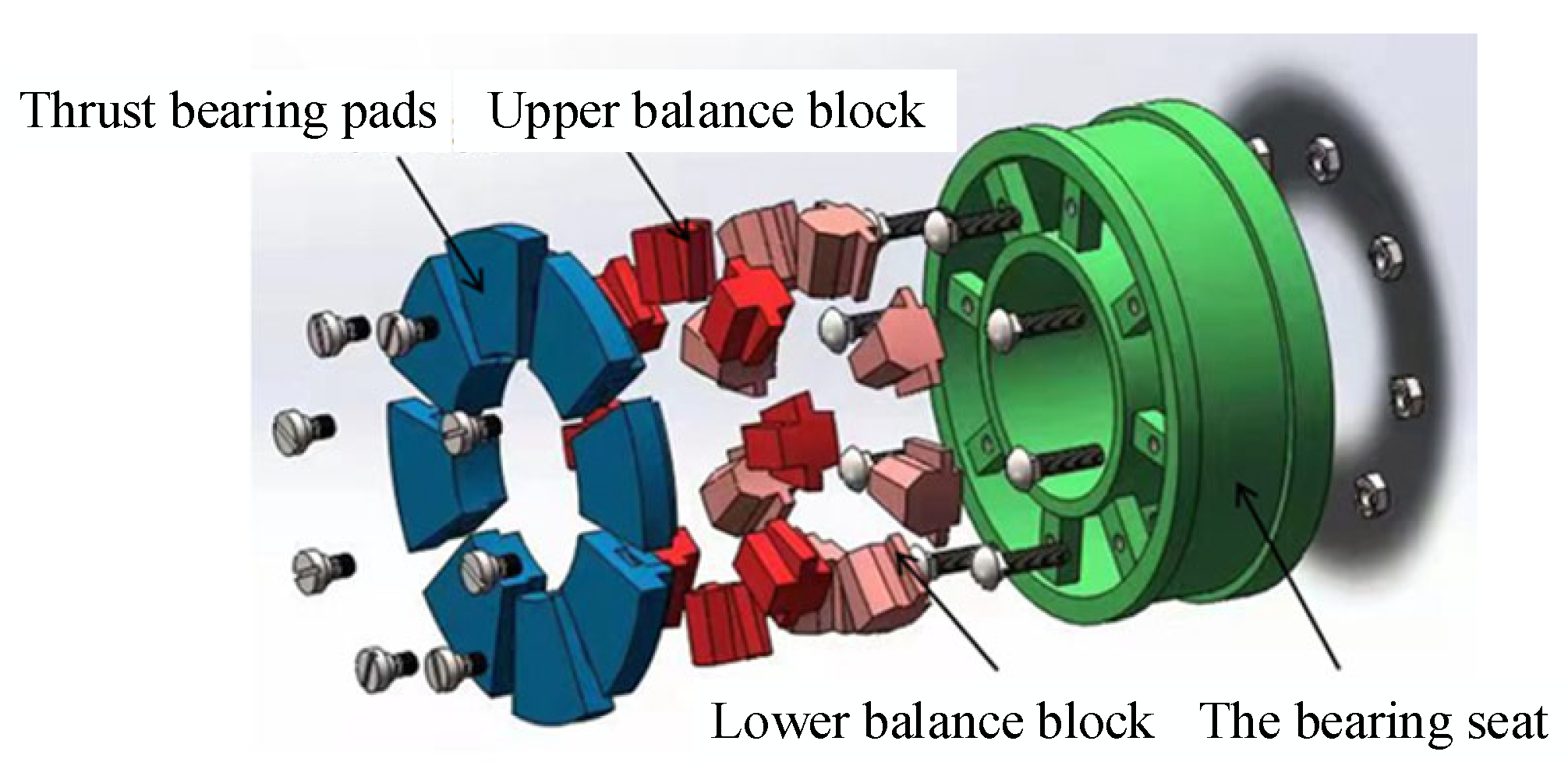
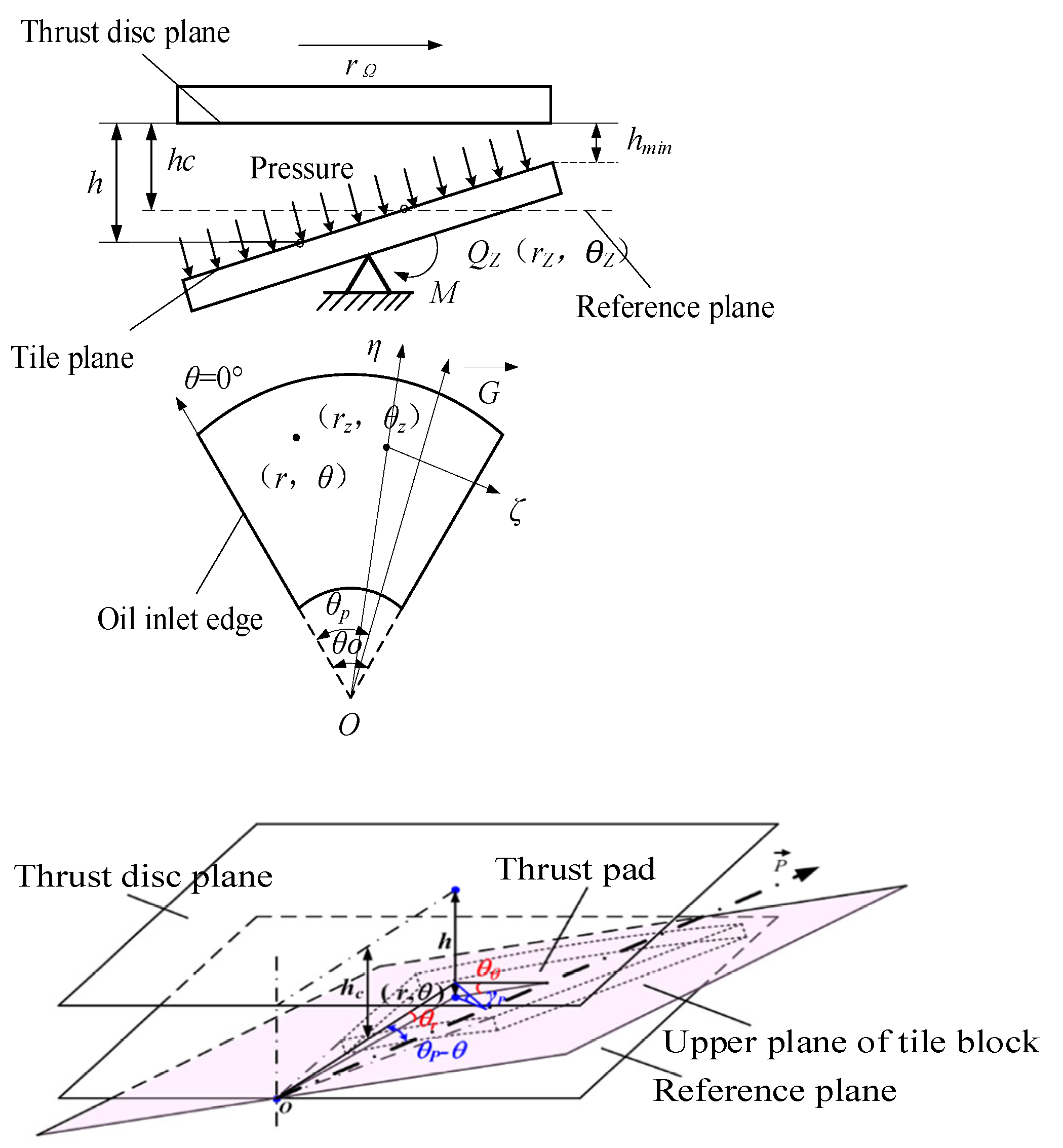

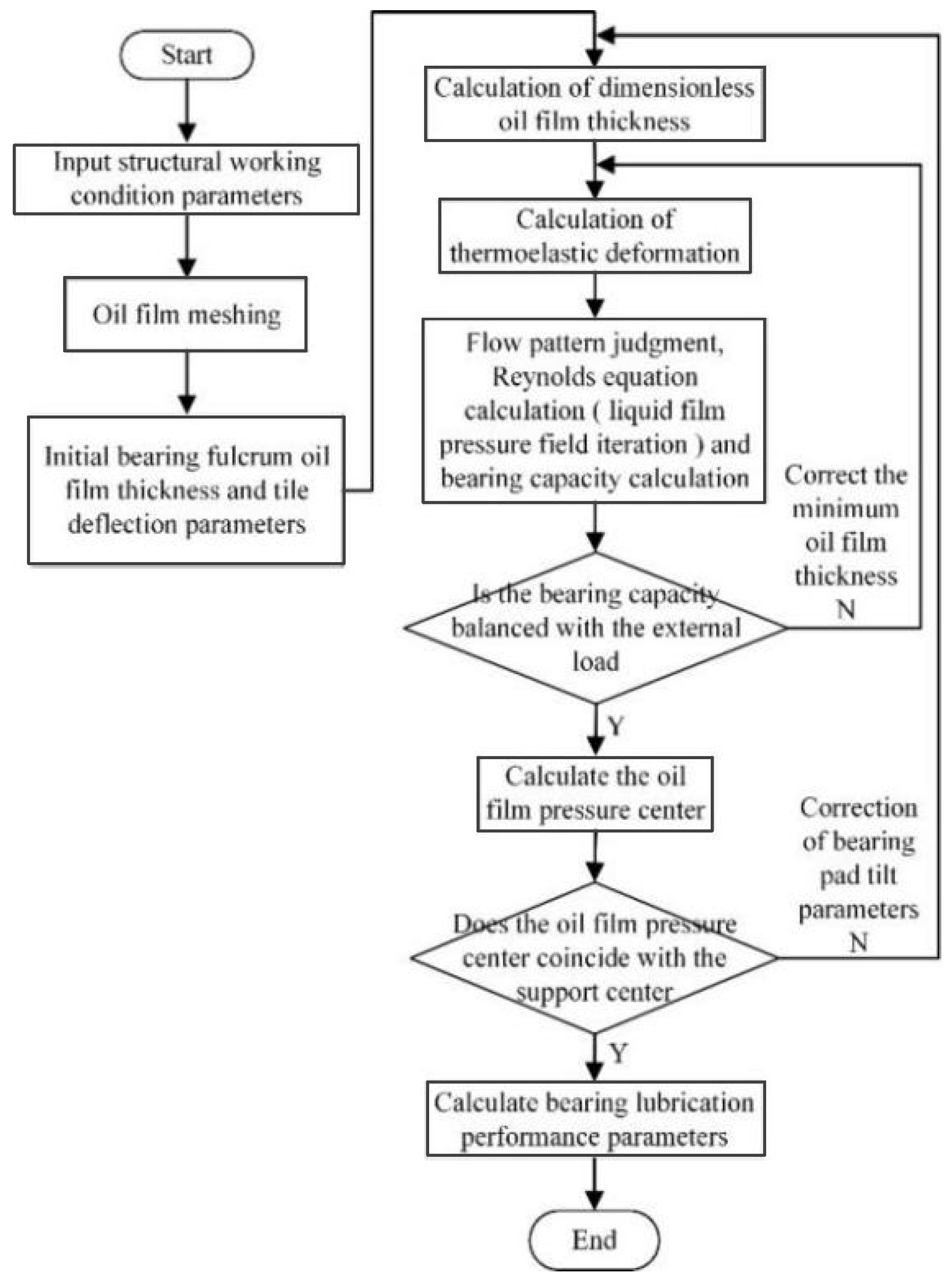
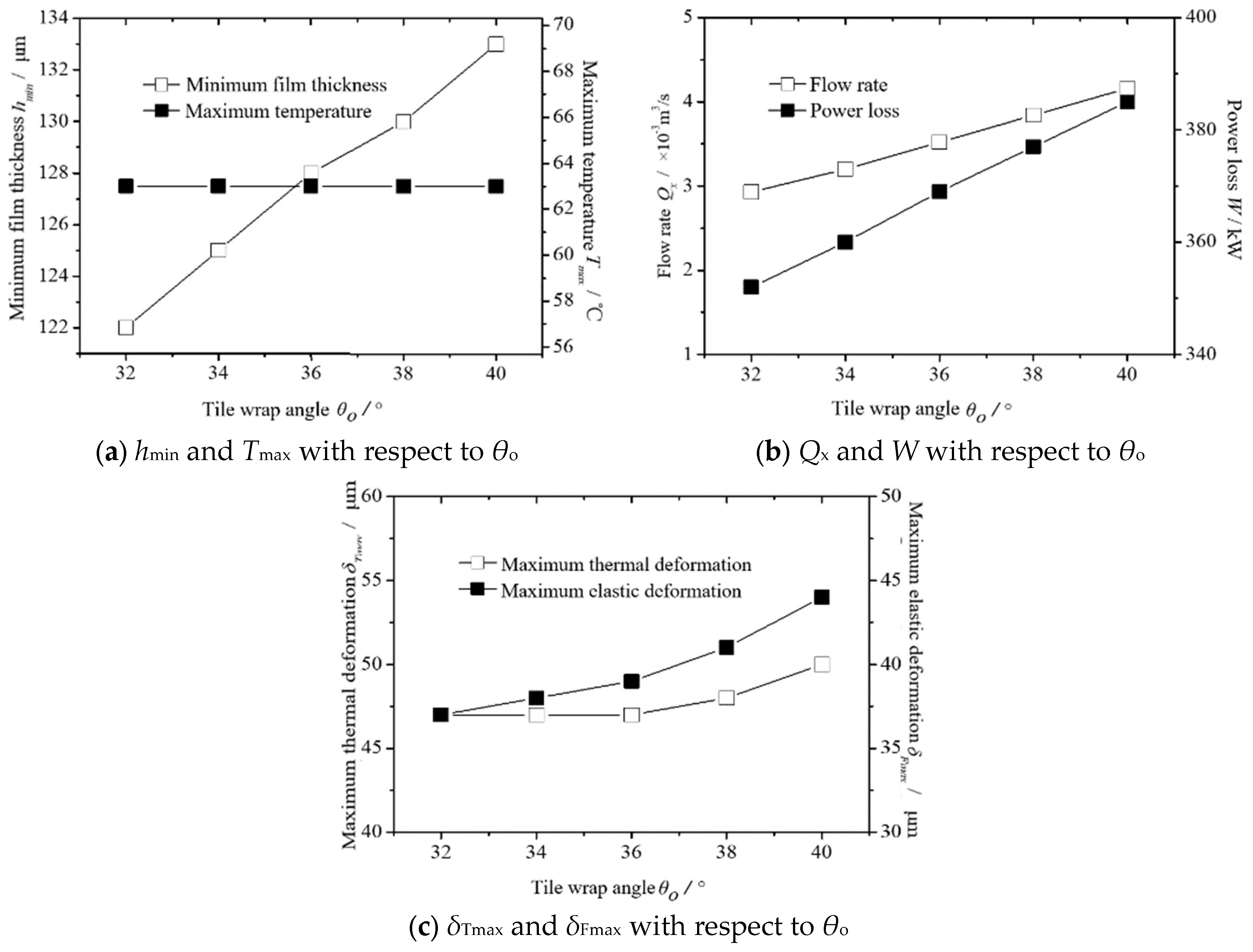
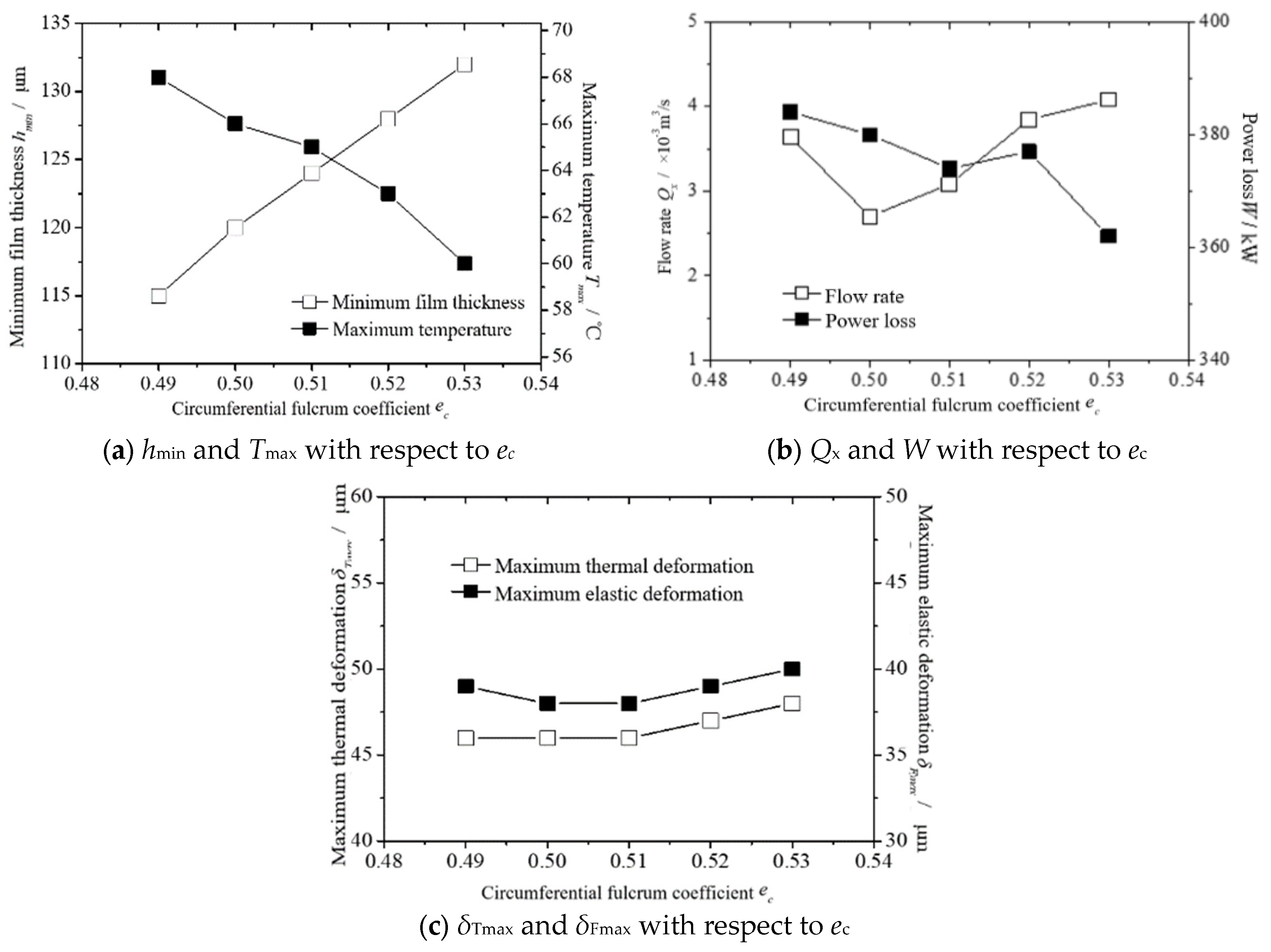

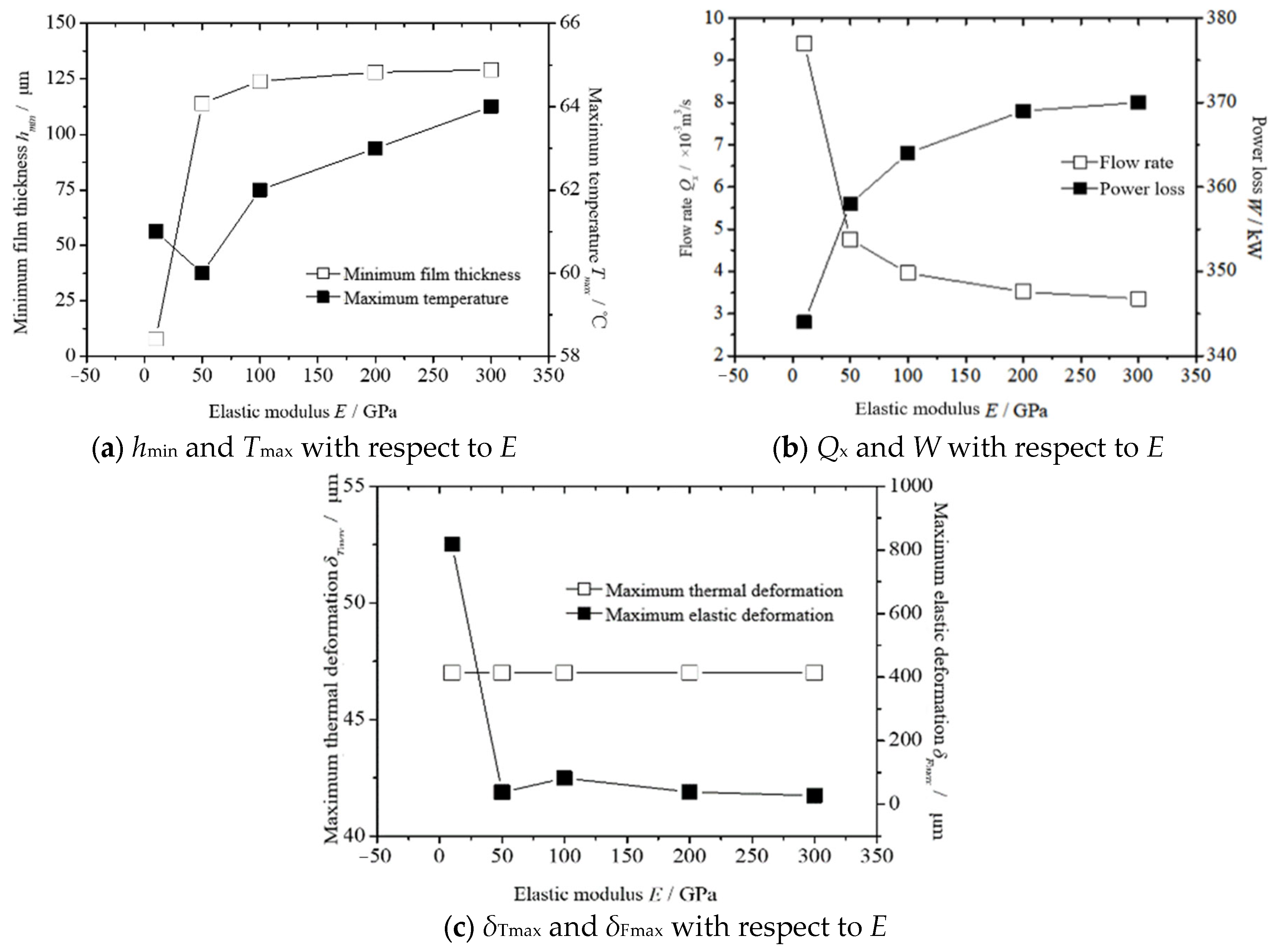
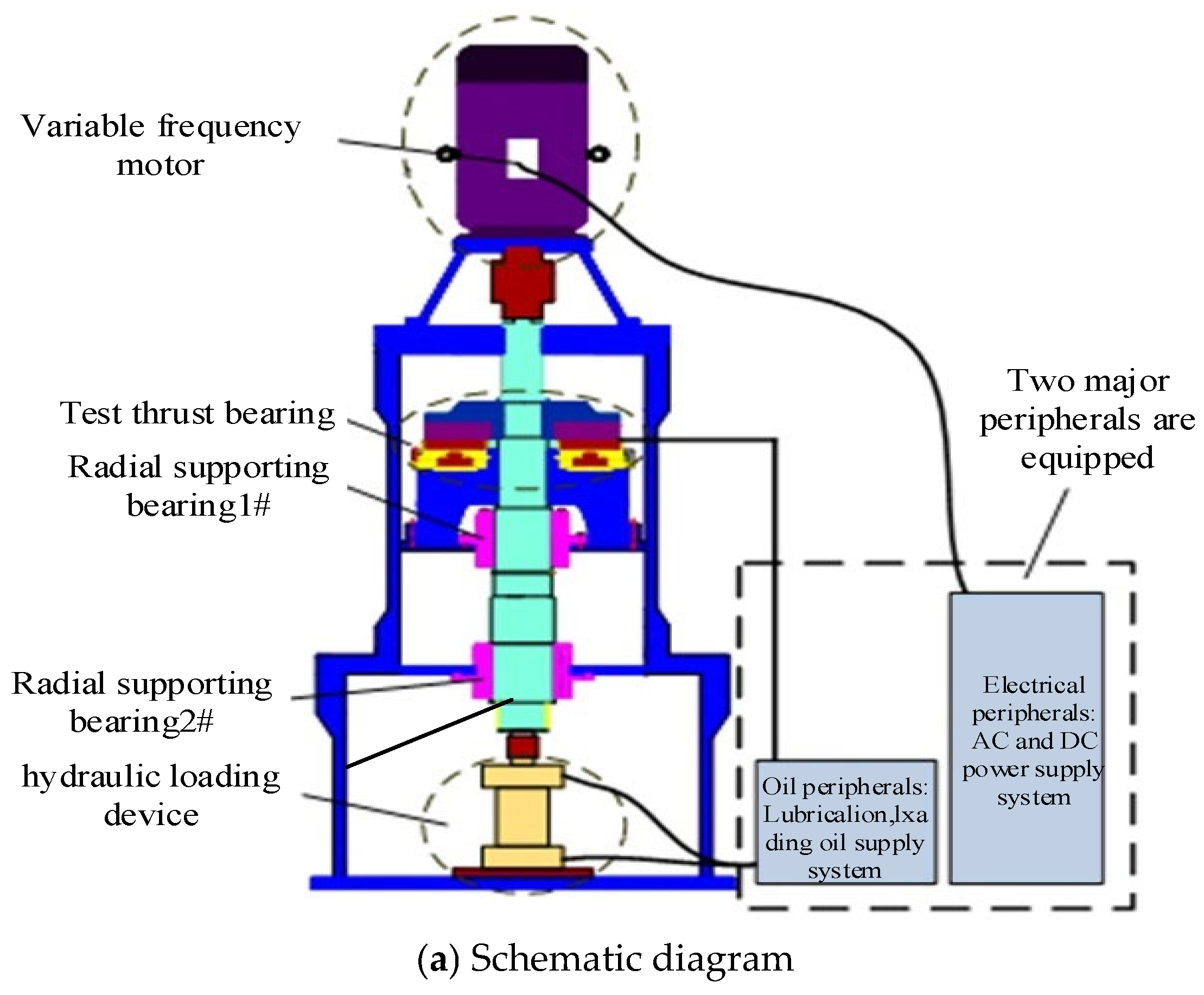
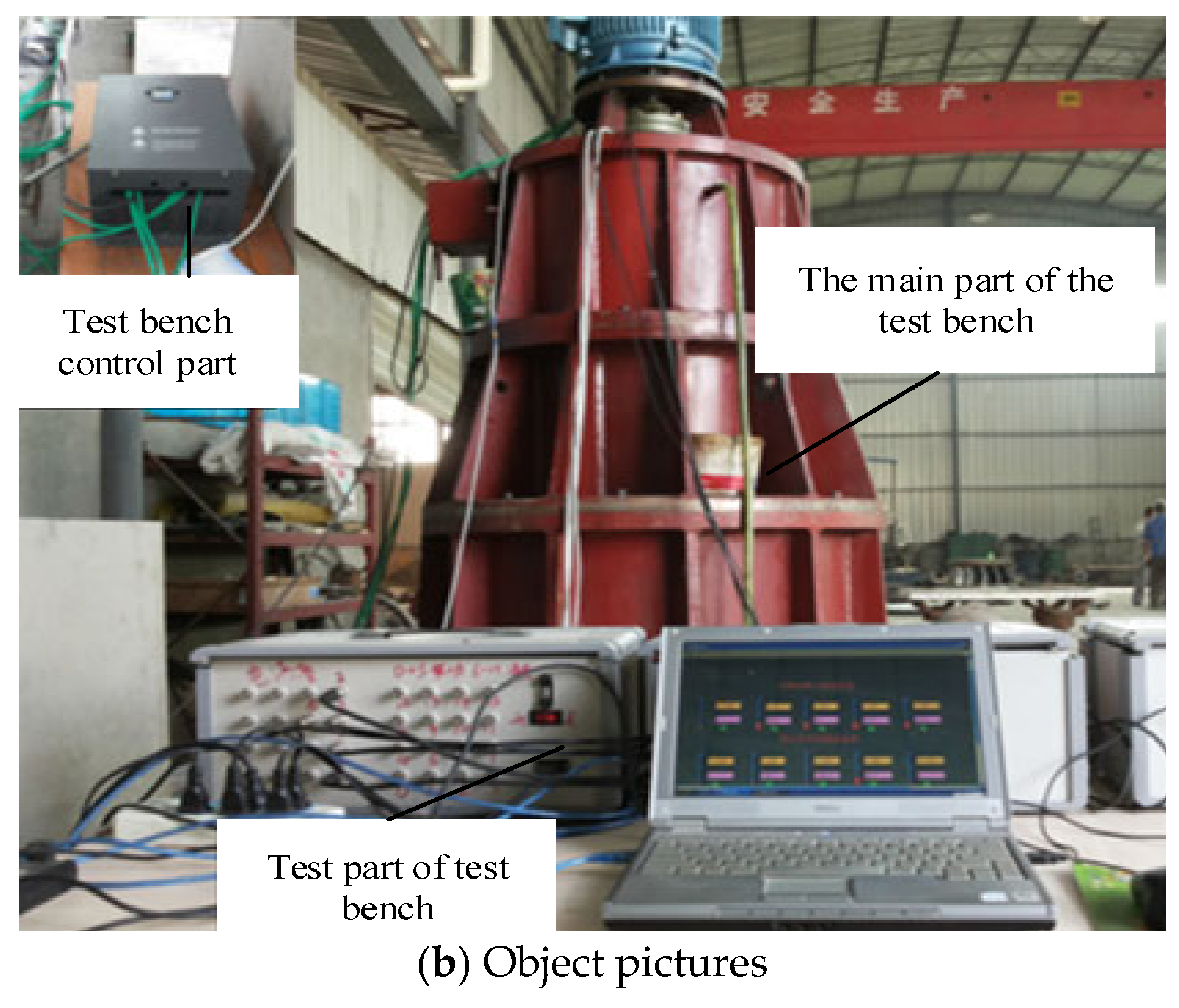
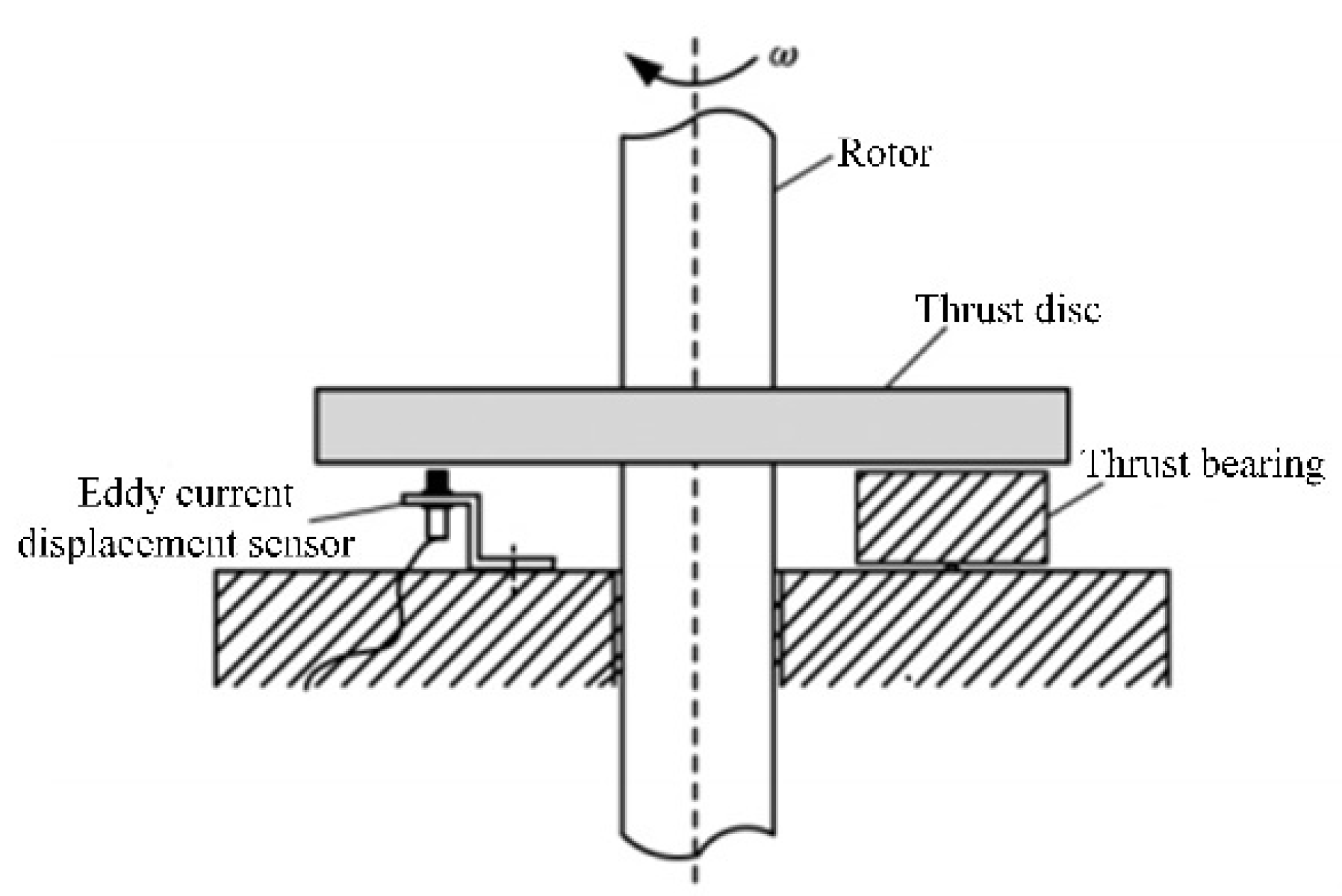

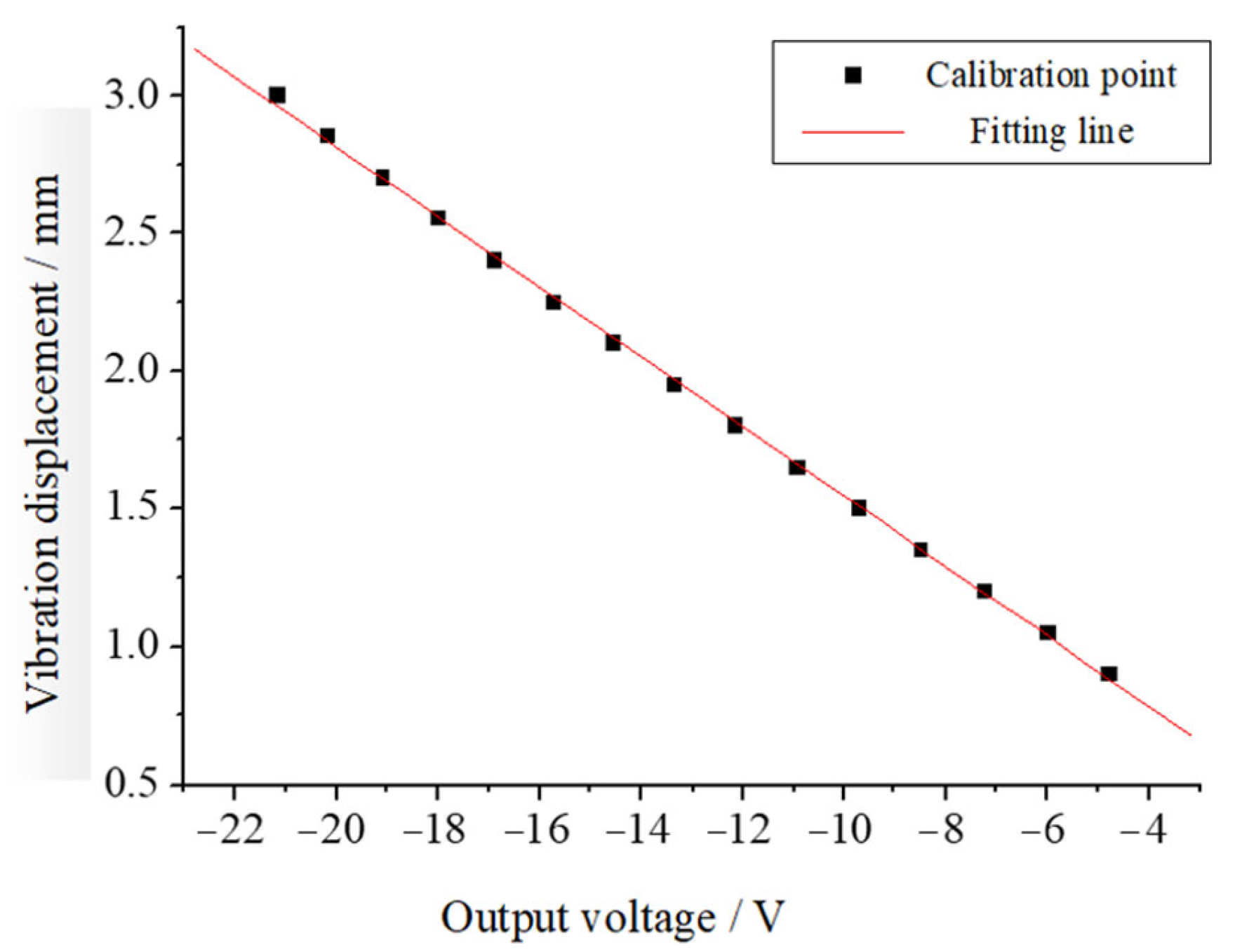
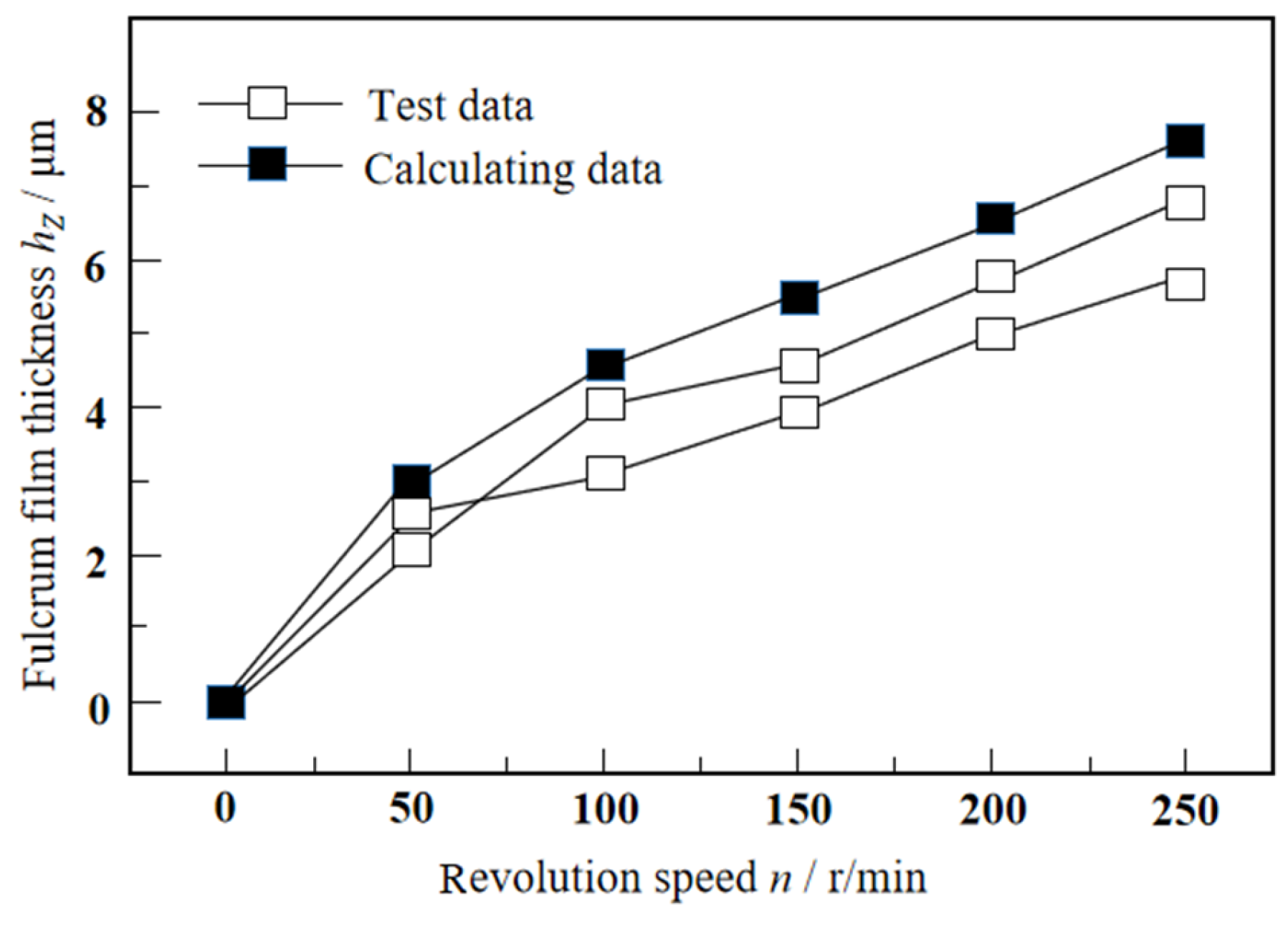
| Parameter Name/Unit | Parameter Values |
|---|---|
| Load: F/kN | Maximum 1000 |
| Speed, n/r/min | 0~1800 |
| The oil supply temperature is H/mm | 40 |
| Lubrication medium | The VG 68 # lubricating oil |
| Parameter Name/Unit | Parameter Values |
|---|---|
| Internal watt diameter, d/mm | 400 |
| Outer diameter of tile, D/mm | 1000 |
| The tile pad is wrapped in θo/° | 36 |
| Radial fulcrum coefficient of tile | 0.5 |
| Periferential fulcrum coefficient of tile | 0.52 |
| Block thickness B/mm | 50 |
| The tile elastic modulus | 200 |
| Number of tile pads | 8 |
| Parameter Name/Unit | Value |
|---|---|
| Bearing bore diameter d/mm | 200 |
| Bearing outside diameter D/mm | 500 |
| The central angle of tile pad θo/° | 36 |
| Radial fulcrum coefficient | 0.5 |
| Circumferential fulcrum coefficient | 0.52 |
| Pad thickness B/mm | 50 |
| Elastic modulus of pads | 200 |
| Number of tiles | 8 |
| Linear Midpoint of Displacement (mm) | Output Linear Midpoint (V) | Equation of Curve-Fitting |
|---|---|---|
| 1.61 | −10.5 | x = 0.27538 − 0.12684U |
Disclaimer/Publisher’s Note: The statements, opinions and data contained in all publications are solely those of the individual author(s) and contributor(s) and not of MDPI and/or the editor(s). MDPI and/or the editor(s) disclaim responsibility for any injury to people or property resulting from any ideas, methods, instructions or products referred to in the content. |
© 2025 by the authors. Licensee MDPI, Basel, Switzerland. This article is an open access article distributed under the terms and conditions of the Creative Commons Attribution (CC BY) license (https://creativecommons.org/licenses/by/4.0/).
Share and Cite
Cao, Y.; Yu, Y.; Gang, H.; Shang, Q.; Meng, X.; Yang, M.; Jia, Q. Experimental Study on Thermal Elastohydrodynamic Lubrication Performance Calculation and Take-Off Speed of Thrust Bearing of Canned Motor Pump. Lubricants 2025, 13, 191. https://doi.org/10.3390/lubricants13040191
Cao Y, Yu Y, Gang H, Shang Q, Meng X, Yang M, Jia Q. Experimental Study on Thermal Elastohydrodynamic Lubrication Performance Calculation and Take-Off Speed of Thrust Bearing of Canned Motor Pump. Lubricants. 2025; 13(4):191. https://doi.org/10.3390/lubricants13040191
Chicago/Turabian StyleCao, Yanjun, Yingjie Yu, Haiming Gang, Qichen Shang, Xiaozhe Meng, Mohan Yang, and Qian Jia. 2025. "Experimental Study on Thermal Elastohydrodynamic Lubrication Performance Calculation and Take-Off Speed of Thrust Bearing of Canned Motor Pump" Lubricants 13, no. 4: 191. https://doi.org/10.3390/lubricants13040191
APA StyleCao, Y., Yu, Y., Gang, H., Shang, Q., Meng, X., Yang, M., & Jia, Q. (2025). Experimental Study on Thermal Elastohydrodynamic Lubrication Performance Calculation and Take-Off Speed of Thrust Bearing of Canned Motor Pump. Lubricants, 13(4), 191. https://doi.org/10.3390/lubricants13040191





